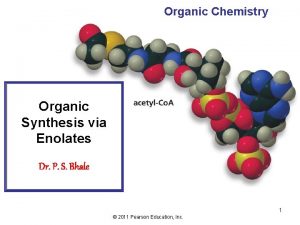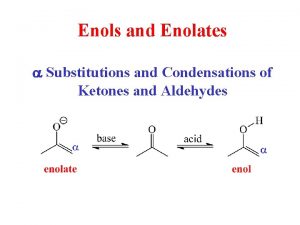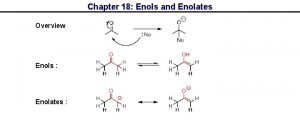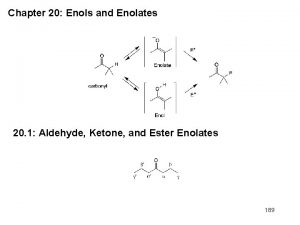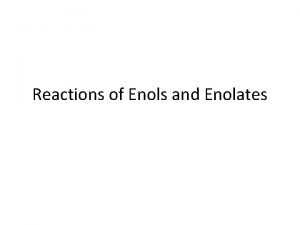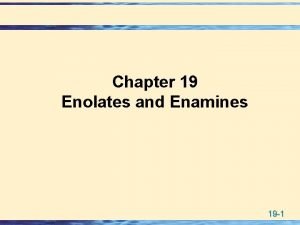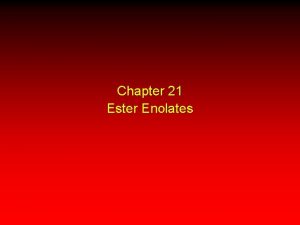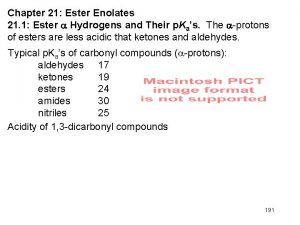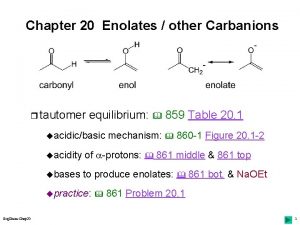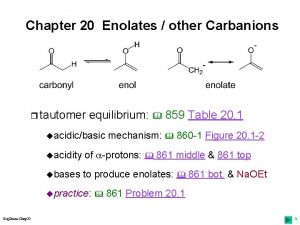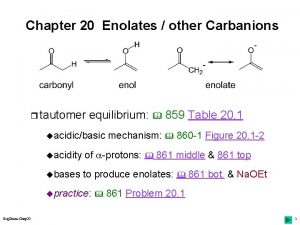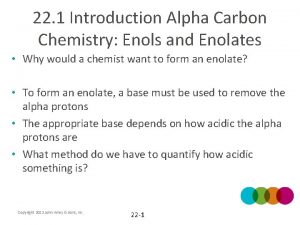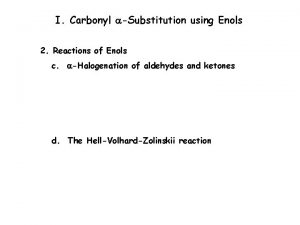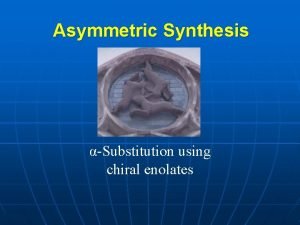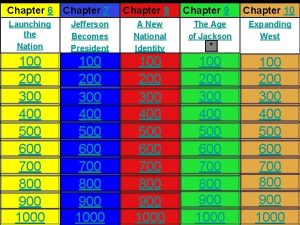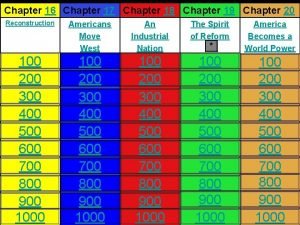Chapter 18 Enols and Enolates 18 1 The





















- Slides: 21

Chapter 18: Enols and Enolates 18. 1: The -Carbon Atom and its p. Ka 126

The inductive effect of the carbonyl causes the -protons to be more acidic. The negative charge of the enolate ion (the conjugate base of the aldehyde or ketone) is stabilized by resonance delocalization. The p. Ka of the -protons of aldehydes and ketones is in the range of 16 -20 (Table 18. 1, p. 754) resonance effect inductive effect ethane p. Ka= 50 -60 acetone p. Ka= 19 ethanol p. Ka= 16 127

p. Ka 19 acid p. Ka 14 16 base conjugate base 19 p. Ka conjugate acid -1. 7 (weaker acid) (weaker base) acid 9 base 19 (weaker acid) (weaker base) (stronger acid) conjugate base conjugate acid 15. 7 (stronger base) (stronger acid) 128

acid p. Ka base 9 (stronger acid) (stronger base) conjugate base conjugate acid 15. 7 (weaker base) (weaker acid) 18. 2: The Aldol Condensation- An enolate of one carbonyl (nucleophile) reacts with the carbonyl carbon (electrophile) of a second carbonyl compound resulting in the formation of a new C-C bond 129

Mechanism of the base-catalyzed aldol condensation (Fig. 18. 1) The position of the equilibrium for the aldol reaction is highly dependent on the reaction conditions, substrates, and steric considerations of the aldol product. Low temperature tends 130 to favor the aldol product.

aldol reactions involving -monosubstituted aldehydes are generally favorable aldol reactions involving -disubstituted aldehydes are generally unfavorable aldol reactions involving ketones are generally unfavorable The aldol product can undergo base-catalyzed dehydration to an , -unsaturated carbonyl. The dehydration is essentially irreversible. The dehydration is favored at higher temperatures. (mechanism Fig. 18. 2) 131

18. 3: Mixed Aldol Reactions - Aldol reaction between two different carbonyl compounds Four possible products (not very useful) Aldehydes with no -protons can only act as the electrophile Preferred reactivity 132

Discrete generation of an enolate with lithium diisopropyl amide (LDA) under aprotic conditions (THF as solvent) THF Lithium diisopropylamide (LDA): a very strong base p. Ka= 19 (stronger acid) (stronger base) p. Ka= 40 (weaker acid) p. Ka= 60 133

18. 4: Alkylation of Enolate Ions - enolate anions can react with other electrophiles such as alkyl halides and tosylates to form a new C-C bonds. The alkylation reaction is an SN 2 reaction. Reaction works best with the discrete generation of the enolate by LDA in THF, then the addition of the alkyl halide 18. 5: Enolization and Enol Content Tautomers: isomers, usually related by a proton transfer, that are in equilibrium 134

Keto-enol tautomeric equilibrium lies heavily in favor of the keto form. C=C C-O O-H DH° = 611 KJ/mol 380 426 C=O C-C C-H DH° = 735 KJ/mol 370 400 DH° = -88 KJ/mol Enolization is acid- and base-catalyzed 135

Base-catalyzed mechanism (Figure 18. 3, 9. 764): Acid-catalyzed mechanism (Figure 18. 4, p. 765): 18. 6: Stabilized enols (please read) 136

18. 7: Halogenation of Aldehydes and Ketones- -proton of aldehydes and ketones can be replaced with a -Cl, -Br, or -I (-X) through the acid-catalyzed reaction with Cl 2 , Br 2 , or I 2 , (X 2) respectively. The reaction proceeds through an enol. 18. 8: Mechanism of Halogenation of Aldehydes and Ketones Acid-catalyzed mechanism (Fig. 18. 5, p. 769) Rate= k [ketone/aldehyde] [H+] rate dependent on enol formation and not [X 2] 137

, -unsaturated ketones and aldehydes: -bromination followed by elimination Why is one enol favored over the other? H+ 18. 9: The Haloform Reaction. Mechanism of the base-promoted -halogenation of aldehydes and ketones (Fig. 18. 6, p. 770) 138

In the base promoted reaction, the product is more reactive toward enolization and resulting in further -halogenation of the ketone or aldehyde. For methyl ketone, an , , -trihalomethyl ketone is produced. The , , -trihalomethyl ketone reacts with aquous hydroxide to give the carboxylic acid and haloform (HCX 3) Iodoform reaction: chemical tests for a methyl ketone Iodoform: bright yellow precipitate 139

18. 10: Some Chemical and Stereochemical Consequences of Enolization (please read) 18. 11: Effects of Conjugation in -Unsaturated Aldehydes and Ketones. -Unsaturated carbonyl have a conjugated C=C R= H, -unsaturated aldehyde= enal R H, -unsaturated ketone= enone Conjugation of the -electrons of the C=C and C=O is a stabilizing interaction 140

-Unsaturated ketones and aldehydes are prepared by: a. Aldol reactions with dehydration of the aldol b. -halogenation of a ketone or aldehyde followed by E 2 elimination 18. 12: Conjugate Addition to -Unsaturated Carbonyl Compounds. The resonance structures of an -unsaturated ketone or aldehyde suggest two sites for nucleophilic addition; the carbonyl carbon and the -carbon 141

Organolithium reagents, Grignard reagents and Li. Al. H 4 reaction -unsaturated ketone and aldehydes at the carbonyl carbon. This is referred to as 1, 2 -addition. Organocopper reagents, enolates, amines, cyanide react at the -carbon of -unsaturated ketone and aldehydes. This is referred to a 1, 4 -addition or conjugate addition. When a reaction can take two possible path, it is said to be under kinetic control when the products are reflective of the path that reacts fastest. The reaction is said to be under thermodynamic control when the most stable product is obtained from the reaction. In the case of 1, 2 - versus 1, 4 addition of an unsaturated carbonyl, 1, 2 -addition is kinetically favored and 1, 4 -addition is thermodynamically favored. 142

1, 2 vs 1, 4 -addition -unsaturated ketone and aldehydes NOTE: conjugation to the carbonyl activates the -carbon toward nucleophilic addition. An isolated C=C does not normally react with nucleophiles 143

18. 13: Addition of Carbanions to -Unsaturated Carbonyl Compounds: The Michael Reaction. The conjugate addition of a enolate ion to an -unsaturated carbonyl. The Michael reaction works best with enolates of -dicarbonyls. electrophile nucleophile The product of a Michael reaction is a 1, 5 -dicarbonyl compound, which can undergo a subsequent intramolecular aldol reaction to give a cyclic -unsaturated ketone or aldehyde. This is Known as a Robinson annulation. 144

145

18. 14: Conjugate Addition of Organocopper Reagents to -Unsaturated Carbonyl Compounds Recall from Ch. 14. 11 the preparation of organocopper reagents Dialkylcopper lithium: (H 3 C)2 Cu. Li Divinylcopper lithium: (H 2 C=CH)2 Cu. Li Diarylcopper lithium: Ar 2 Cu. Li -unsaturated ketones and aldehydes react with diorganocopper reagents to give 1, 4 -addition products (C-C bond forming reaction) 146
 Acetoacetic ester synthesis mechanism
Acetoacetic ester synthesis mechanism Aldol condensation
Aldol condensation Hát kết hợp bộ gõ cơ thể
Hát kết hợp bộ gõ cơ thể Slidetodoc
Slidetodoc Bổ thể
Bổ thể Tỉ lệ cơ thể trẻ em
Tỉ lệ cơ thể trẻ em Voi kéo gỗ như thế nào
Voi kéo gỗ như thế nào Glasgow thang điểm
Glasgow thang điểm Alleluia hat len nguoi oi
Alleluia hat len nguoi oi Môn thể thao bắt đầu bằng từ đua
Môn thể thao bắt đầu bằng từ đua Thế nào là hệ số cao nhất
Thế nào là hệ số cao nhất Các châu lục và đại dương trên thế giới
Các châu lục và đại dương trên thế giới Công thức tiính động năng
Công thức tiính động năng Trời xanh đây là của chúng ta thể thơ
Trời xanh đây là của chúng ta thể thơ Mật thư anh em như thể tay chân
Mật thư anh em như thể tay chân Phép trừ bù
Phép trừ bù Phản ứng thế ankan
Phản ứng thế ankan Các châu lục và đại dương trên thế giới
Các châu lục và đại dương trên thế giới Thể thơ truyền thống
Thể thơ truyền thống Quá trình desamine hóa có thể tạo ra
Quá trình desamine hóa có thể tạo ra Một số thể thơ truyền thống
Một số thể thơ truyền thống Cái miệng nó xinh thế chỉ nói điều hay thôi
Cái miệng nó xinh thế chỉ nói điều hay thôi
